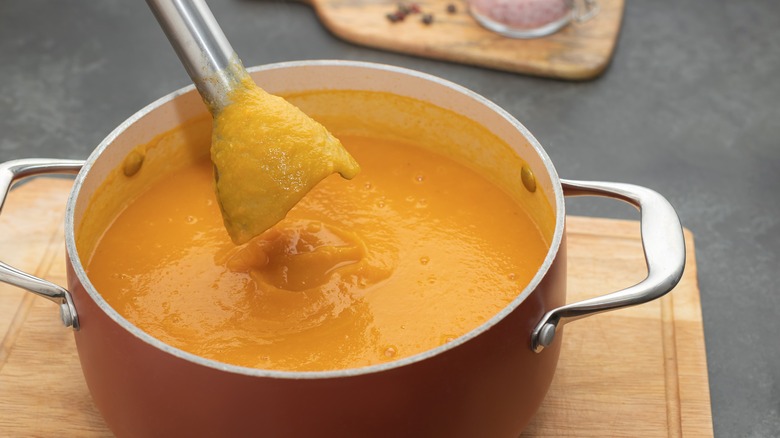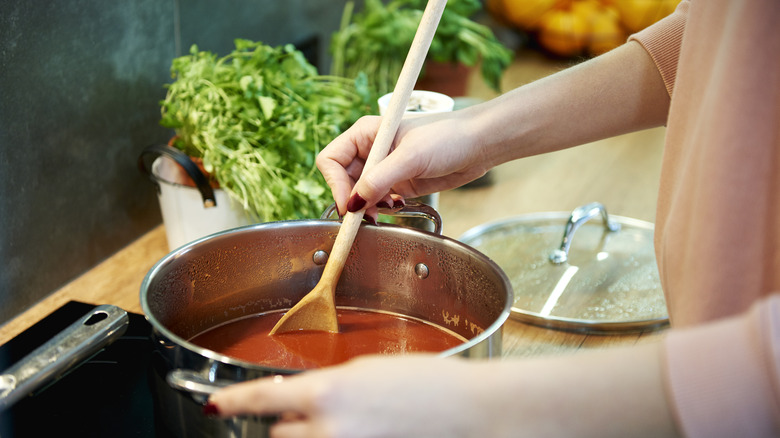Tofu Is The Plant-Based Way To Thicken Your Soup
Tofu is not just a protein-rich meat alternative, a hefty addition to a stir fry, or a satisfying scrambled egg dupe. The ancient, fermented soy based food featured in Asian cuisine is also a secret weapon for thickening your soups. Because the protein source offers up nearly no detectable flavor of its own and blends into a silky smooth consistency, it's a no-brainer to blend up and use in smoothies, rich pudding desserts, and yes, creamy soups. While it might not be the most obvious way to use that block you have sitting in your fridge, it's an ingenious one, especially for the plant-based crowd, those sensitive to dairy, or anyone wanting to simply infuse a little extra decadence and protein to your one-pot meal.
Many plant-based soups gain their thick mouthfeel and texture from blended soaked cashews or canned coconut cream, both of which add the same dense richness a heavy whipping cream traditionally would. Blended tofu achieves the same thing, adding a similar weight and silkiness, sans the fat of nuts or coconut milk or the dairy or cholesterol from traditional cream. Depending on the recipe at hand, you may want to pre-cook cubed or sliced tofu and then use an immersion blender (or regular one) to cream it up before stirring into your soup. But you can also skip the cooking entirely and simply blend the raw tofu directly in with the rest of your soup ingredients and cook together for comfort food perfection.
Tofu adds very little flavor of its own, but brings the creaminess
Many soups feature cubed or chunked tofu — from traditional miso soup you might order in an Asian restaurant to brothy favorites like ramen or pho. And in most cases when cooking with tofu, you'll need to properly prep it, squeezing out the excess water, and then generously seasoning it to avoid the bland, mushy, flavorless tofu that gives the dish its undeserved bad rap. In the case of adding to soups though, we're blending it right into the base of the soup, not cubing it up, and the flavorless nature of the soy protein works in our favor, as it slips undetected into nearly any recipe.
You can try using the plant-based staple in a multiple of applications, like a hearty pumpkin soup, an Asian-inspired ginger peanut concoction, or simple, unbeatable tomato soup. It's also the perfect addition to a velvety cream of mushroom soup for the base of all your holiday casseroles or a luscious potato leek soup to cozy up with this season. Much like sneaking spinach into a fruit smoothie or making plant-based cheese sauces chock full of hidden potatoes and cauliflower, adding blended creamy tofu brings very little flavor of its own — so picky diners or those skeptical of the vegan protein will be none the wiser — but adds velvety texture and hidden nutrition.
Use what you have, though silken reigns supreme
In most grocery stores, you'll find the tofu selection in the produce aisle, perhaps unexpectedly, often hanging out with the other plant-based alternatives like tempeh, vegan cheese, refrigerated dips and sauces, etc. Most retailers offer tofu in a few varying textures from silken or soft to firm, extra firm, and in some cases extra extra firm or sprouted varieties. Each has a time and a place, depending on the recipe at hand. The dense, firm versions contain less water and provide more protein, and are much better suited to instances like grilling or sauteeing, when you need your tofu to hold up to being pressed, flipped, blackened, and more.
For soups, almost any type will do — you can certainly use the firm style, especially if you plan to cook your tofu before blending and mixing in (you'll get more protein this way, ounce for ounce). But the slippery, spoonable silken style is your best bet for most cream-based soups, think pureed butternut or squash soups or a plant-based spin on broccoli and cheese, since it effortlessly blends like a dream until smooth and pourable. Just be mindful when choosing your style, the more soft and silken you go, the more liquid you'll be adding to your soup, so you may need to adjust your recipe and ratios to account for the additional water. Another perk to the silken style is it tends to be very cheap and often is sold in bulk, shelf-stable packaging, so you can stock up and keep extra in the pantry all soup season long.


